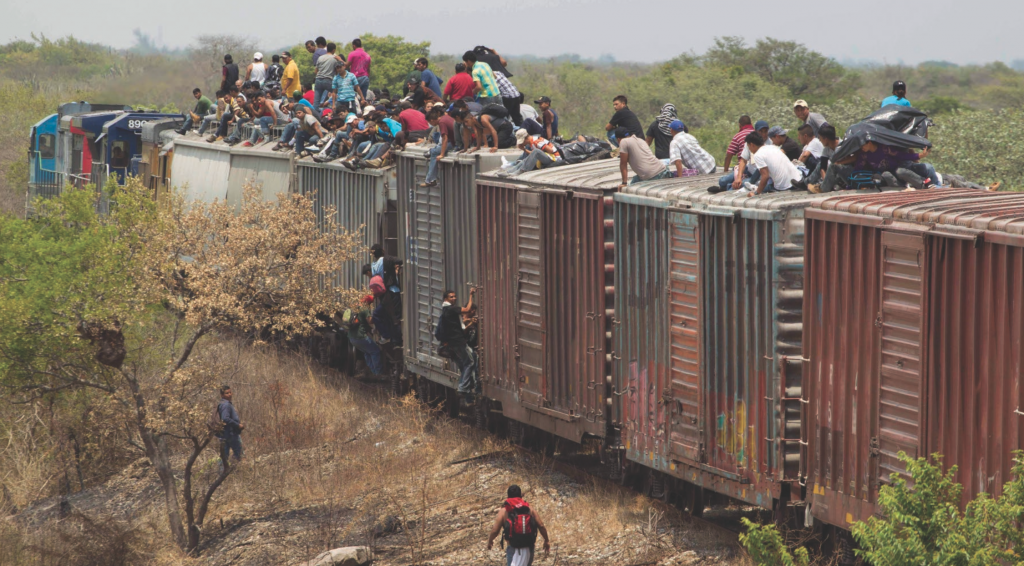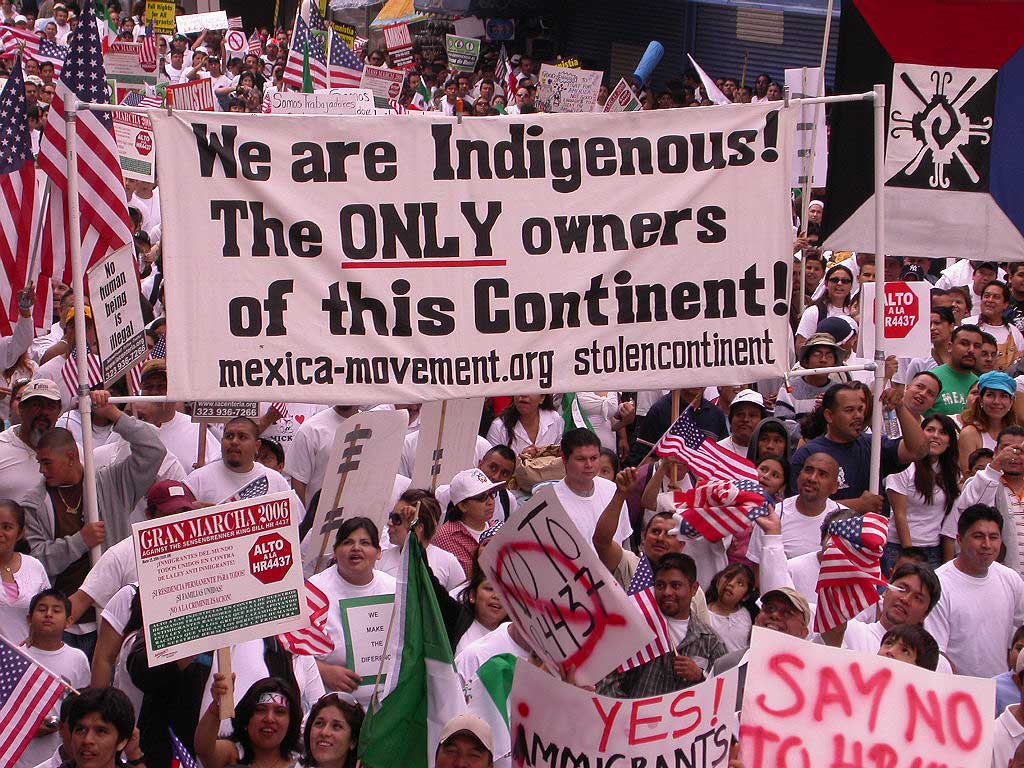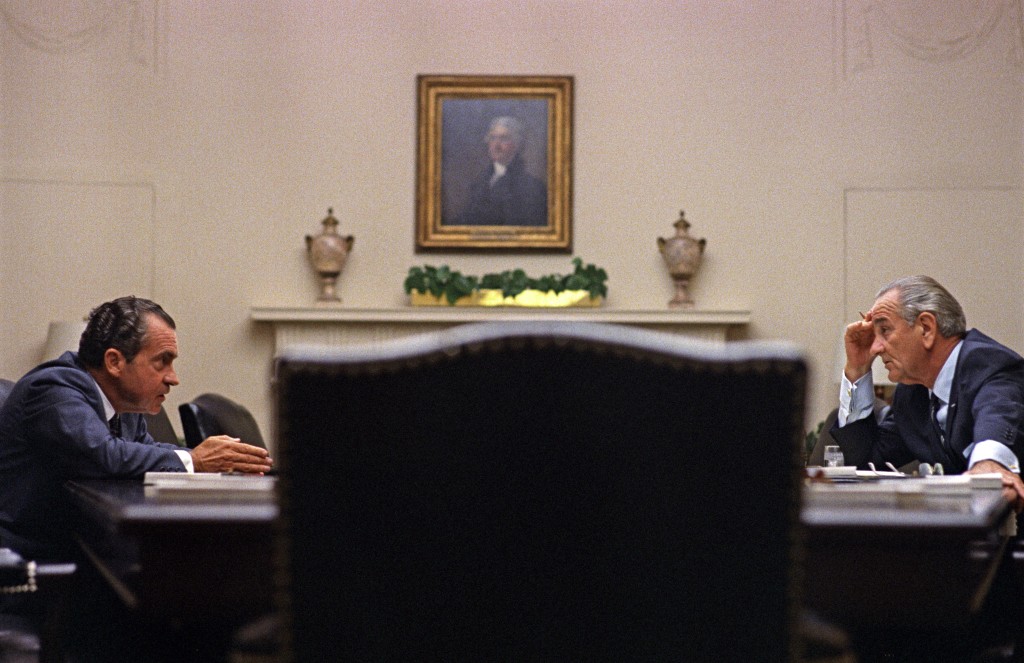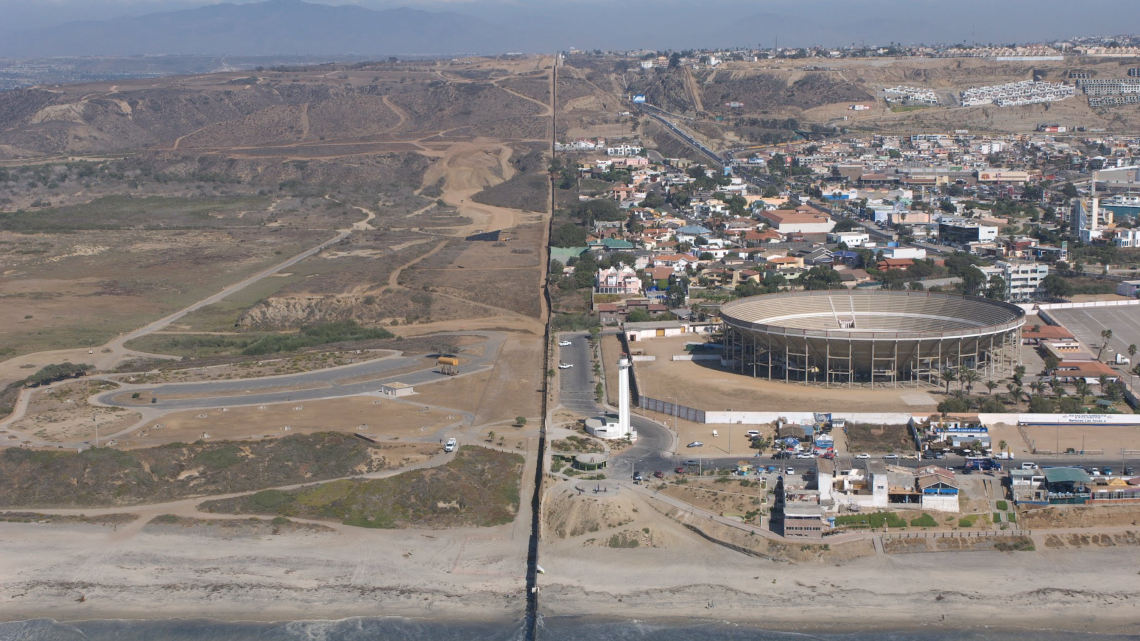Somewhere along la frontera and deep in Latin America are missives of tears and starvation aplenty, but what is missing from the discussion among the primary power brokers and pundits of U.S. immigration and “the crisis in Central America” of women and children is any semblance of a lineage of truth. What we get instead is a constant shuffling of blame and excuses about why nothing has changed. The real story of immigration today is best borrowed from a term popularized by the late Ronald Reagan. The immigration problem is a “trickle down” or better yet a “voodoo economics” of human life and migration, only no one is putting the puzzle pieces together to talk about what is actually going on. The question of immigration and immigrants has been in the news probably since the very notion of “citizenship” emerged, but in the American context of late it’s taken on a far more smoldering character, that now, thanks to media talking points and shallow analysis, awaits its next iteration and connection to the War on Terror narrative.
As an audience of rabid media consumers, we have stopped asking why this connection between war, global policing, and immigration needs be made as a matter of state policy or public thematic. Perhaps the reason is best explained as an ongoing extension of a root infrastructure based on racism, exploitation, and asymmetrical power relations. Instead, the cynics assume it’s but policy pandering and manipulation, while those more accepting of the status quo genuinely assume there is a drug cartel ready to pounce, or an illegal waiting to steal their job. It doesn’t matter which formula is used—immigration under this framework becomes an “American problem” in need of “American leadership,” which is to say it is a U.S. problem calling for an ever-increasing array of rhetoric and interventionism on the part of Washington, D.C. The actuality on the ground, however, is more complicated, but no less grotesque a headline. Indeed, a continental situation of crisis proportions has emerged and neither its causes nor affects are easy to outline or determine.

Former U.S. Secretary of State Hillary Clinton with Honduras’ then-President Manuel Zelaya. Courtesy of the Internet.
In the last few years the term “migration” has been thrown around and used to displace and describe the phenomena of mass immigration. Those on the American left have begun to do so seeking a more genteel language, fitted with decorative butterflies even to make it seem more palatable for the uninitiated and xenophobic. Yet the situation is such that daily broadcasts and news stories are filled with images and pieces about masses of children, families, orphans, refugees, individuals, and peoples gravitating from country to/through country as if proverbial hot potatoes. These individuals are consistently passed off as someone else’s problem, until the pitiable human refuse in need of saving or condemning find themselves settled in el norte or elsewhere, wherein a charitable, missionary hand offers a future where survival is possible, ever so patiently fulfilling our own Kipling burden of being helpful and exceptionally American. What everyone in the equation is finding, however, is far from ideal, and much closer to false hope and optimism.
While women and children seem to travel in exodus out of places like Guatemala, El Salvador, and Honduras, the shadow of post Cold War Central America is rarely referenced in the media’s friendly explanation of their story. They stand as human relics of a bygone era that were disallowed from standing before American popular memory as refugees from a common past in which the question of democracy and freedom might not have been all that friendly an affair. Instead, the immigrant, the migrant, the exile, and the refugee stand before an absent history save that which is iconographic for what is “trending” and worthy of a hashtag. They can be photo ops and sympathetic receptacles from which American guilt can be assuaged with a dollar amount, but they cannot be bearers of history that might cause us to question the benevolence of #Pax Americana.
The history emptied out of the immigration debate isn’t even that old, though it is pre-9/11, and like many things prior to that date its nuances and importance seem lost in light of an “attack upon America” or our “way of life.” But the human refuse left over after what was done elsewhere in the name of American freedom and prosperity now stands in front of us, bereft of home, health, and job by the Free Trade Area of the Americas (FTAA), death squads, cartels, poverty, starvation, structural readjustment, and coups backed by the United States. It was the benign neglect begun under “Dubya” that seemed to free Pandora’s box. As U.S. foreign policy shifted toward the Middle East and a perpetual war on terror, much of Latin America and the Caribbean were left as an untended “backyard,” to use the Beltway parlance. Already plundered by gunboat diplomacy, tin pot dictators, banana republics, and proxy fiefdoms, the future fate of sur de la frontera (south of the border) had already been predetermined in the minds, plans, and backrooms of Washington. Or so they assumed.
Their blueprint basically expected a continuation of the “same old, same old,” which is to say—compliance. But as children, gardens, and herds left untended tend to do, things went awry. Weeds sprouted and unwatered seeds never grew or even died disrupting the idea of an “end of history” for the region. Thus a hungry new political crop began to replace the old and succeeded in subverting all those dreamy notions of compliance. Progressive leftward mass-movements seized power throughout the region, except in places where U.S. clientelism and interventionism was most paramount, such as in Honduras, Haiti, and Colombia (but even that can change). Today these contemporary and convoluted echoes of history are ignored, creating a cascading continental tragedy, an inheritance of a bitter set of crops, if you will. Negligence has left us with but two questions: what actually happened then and what is actually happening now?

Central American migrants risk life and limb riding freight train wagons to reach the U.S. Courtesy of the Internet.
A Broken Workshop
The Cold War for the most part ended in the late 1980s, but post Cold War U.S. policy toward Latin America didn’t solidify until the early 1990s with the establishment of the North American Free Trade Agreement (NAFTA). NAFTA rewrote the geo-economic relations of the hemisphere, most specifically between the U.S. and Latin America. Following the “success” of NAFTA, its smaller cousin the Central American Free Trade Agreement (CAFTA) came into being, and thus NAFTA became the FTAA. With the rise of the maquiladora, industrial cities became factories, resurrected “company towns” as economic Bantustans, and transnational agri-corporations penetrated Latin American domestic markets creating a rural flight pattern of the impoverished into the major urban centers throughout the hemisphere. Those cities, overwhelmed by a demand for jobs they were incapable of fulfilling and exhausted of economic opportunity or social safety nets, became launch pads into a pipeline of transnational mobile job seekers venturing ever northward into the virtually unregulated arms of a U.S. job market salivating for cheaper and cheaper labor. It is from this initial transformation that our contemporary “immigration” crisis was born.
In the boom and bust economy of the ‘90s, two simultaneous precedents were set; that of the formalized restructuring of U.S. economic relations with the global south, and the dot.com bubble burst. The rise of Silicon Valley’s non-permanent contract workers and the necessity of an H-1B visa reform movement were born. Ironically, the former wealthiest corporation on Earth, Apple, was in fact the cost cutting leader in that period. With massive layoffs and rehires of re-statused “temporary” labor, Apple was not only able to weather the recession but in fact flourish, grow, and profiteer. Its business practices became the new standard not just for Silicon Valley but for the industry as a whole. Never mind the fact that the then-CEOs throughout the Valley were colluding in a criminal conspiracy to reduce and fix wages and enter into an illegal non-competition agreement regarding hiring and “poaching” one another’s employees. Strangely, in the glitter and glamour of the faux Camelot aura of New Democrat Clintonianism, not only was the marriage of Silicon Valley and Democratic Party politics concretized as so aptly covered by Sara Miles in a 2002 issue of Wired magazine, but the very essence of the New Corporatist work ethos of Silicon Valley was borrowed and adapted from Hollywood magic man George Lucas in the way he controlled his own costs and workers. California ideology had indeed come full circle; who needs an Ayn Rand when you have Luke Skywalker’s real daddy at the helm?
These two worlds of immigration and workers’ needs couldn’t have contrasted each other more. Computer engineers, programmers, and machine language jockeys poured forth from Pakistan, India, Taiwan, and China to fill out what seemed to be human factories of technically savvy employees to feed the Information Age. Meanwhile, the rapid impoverishment of the continental south created an endless stream of under-skilled, low-income labor to make sure this new epoch full of Silicon Brahmans, Cyber Mandarins, and Technorati remained fed, fatted, clothed, and serviced. This was the new reality, one veiled by the euphoric blindness of easily accessible credit and gilded dreams of prosperity. The shot heard around the world that would emanate from Thailand, Indonesia, and South Korea was a discharging canon of crashing home loans begun in 1997. The War on Terror quickly became passé for a brief window as the global financial crisis took hold of Washington’s leadership at the highest levels. But what happened just prior to credit default swaps, subprime loans, underwater mortgages, and the greatest transfer of wealth in human history? The Immigrant Rights Movement was reborn.
El Gigante Awakens
In 2006, millions of documented and undocumented immigrants and their children marched throughout the U.S. in an unprecedented display of popular dissent. They were one of the largest demonstrations in U.S. history and the first by those in defense of so-called “illegals” against the gross criminalization of their desire for prosperity, a humane life, and family unity. The proposed H.R. 4437, or Sensenbrenner Bill, came on the tail of Patriot Act (2001) and Patriot Act II (2003) hysterics. Among many other things, the bill sought to criminalize any association with undocumented peoples as “harboring a criminal” and thus a criminal offense. So outraged were the unrepresented and silenced underclass of predominantly Latino workers that over the span of three months (March, April, and May), millions of people took to the streets. As things began to heat up, their slogan of protest was transmuted by Democratic Party operators from “No on H.R. 4437” to “hoy marchamos, mañana votamos” (today we march, tomorrow we vote). One must admit this is a rather convenient play on words during an election cycle, made all the more strange considering it was applied to an utterly and legally disenfranchised population and movement. The demands of the people seemingly achieved, the Sensenbrenner Bill disappeared. Or did it?

March 26, 2006, between a half-million and a million people protest the anti-immigration bill, H.R. 4437.
Within a year a new wave of particular legislation and action took effect—2006 marked the beginning of the most frightening sequence of anti-immigrant sentiment and policy the U.S. had seen or employed since the time of the Palmer Raids (1919–1920) and Operation Wetback (1954). Ostensibly, Operation FALCON (Federal and Local Cops Organized Nationally) I, II, and III were a multi-phased dragnet that took place over weeks across all fifty states targeting federal fugitives. The final results of which were the largest recorded number ever arrested in the span of a single operation: an excess of 10,000 people. To be sure many of those arrested were in fact “criminals” it was no accident that a large number of those taken into custody happened to be undocumented foreign nationals. In volley of tit for tat actions the first of the major pro-immigrant demonstrations took place between March 10th–31st, while the next phase of Operation FALCON II raids took place April 17th–23rd. Responding with growing discontent, ever larger immigrant rights demonstrations took place throughout the country from April 1st–May 1st, with estimated participants in the millions. In the years that followed 2006, under two presidential administrations, more immigration incarceration and deportation has occurred than in any other time in U.S. history. Some have even begun to refer to Obama’s administration as “The Great Deportation.”
What has been conveniently overlooked and forgotten in most of the rhetoric around immigration is the actual origins of contemporary immigration policy. In American popular mythology about immigration, like citizenship, it is seen as a mechanism held up in light of racially narrow family histories rooted in the Statue of Liberty’s call to “give me your tired, your poor, your huddled masses yearning to breathe free.” Immigration is yet another political issue in dire need of fixing in a broken regulatory system, a system by which one can ultimately obtain a path to citizenship. The problem with these assertions is that the H-1B “workers visa” didn’t come into existence until the mid-‘60s as part of President Lyndon Johnson’s Immigration and Nationality Act of 1965. As he signed the legislation into law Johnson stated:
“This [old] system violates the basic principle of American democracy, the principle that values and rewards each man on the basis of his merit as a man. It has been un-American in the highest sense, because it has been untrue to the faith that brought thousands to these shores even before we were a country.” (October 3, 1965)
Unfortunately, this law very specifically states that the H-1B visa is a “non-immigrant visa” (section 101(a)(15) (H)). Within a few short years under the administration of then-President Richard Nixon the laws regulating immigration were supplemented and modified as part of the Omnibus Crime Control Act of 1970. Upon signing the law, Nixon said:
“. . . I AM SIGNING into law today the Omnibus Crime Control Act of 1970. . . . Our goal is the increased effectiveness of our criminal justice system in order to reverse the unacceptable trend of crime in our Nation. From our efforts in the Nation’s Capital, we are already learning that this trend can be reversed. By applying new techniques and adding resources, we have been able to halt—and even to reverse—the spiraling crime . . .” (January 2, 1971)

Lyndon B. Johnson and Richard Nixon meet in 1968.
Nowhere does Nixon mention immigration or a path to citizenship as a paramount issue (let alone a second thought) in the bill’s authoring nor in its implementation. But it was this bill that began the “war on crime” and the beginning of the legislation for “securing the borders.” From its very beginnings, contemporary immigration has been framed as a criminal, not civil, matter. In the 1700s citizenship was limited to “free white persons” of “good moral character,” those Indian savages and recalcitrant three-quarters of men living as slaves need not apply. Naturalization by geography of birth didn’t even emerge until almost a full century later, after a civil war had been fought. Nonetheless, by the 1900s a quota system was established in such a way that specifically emphasized European paths to immigration and citizenship, as long as they weren’t “subversives.” These are the various laws and legacies to which President Johnson is referring. Not that it really changed that much, because as Senator Edward Kennedy stated at the time when discussing the Immigration and Nationality Act of 1965:
“. . . the bill will not flood our cities with immigrants. It will not upset the ethnic mix of our society. It will not relax the standards of admission. It will not cause American workers to lose their jobs.” (February 10, 1965)
One must ask what it did, what it has done, and what reforms have been done since? The simple answer is that it codified into black-letter law the system by which ongoing criminalization statutes could be strengthened, refined, reinforced, and ultimately enforced upon a very specific population. Thus it was no surprise that in the voodoo soup that was Ronald Reagan’s 1980s, narrow refugee and immigration quotas and ceilings were established as a means of regulating both wanted and unwanted immigration. For the first time criminal and fiduciary penalties were established for employers that knowingly hired undocumented workers. So broken was the system that a general amnesty was granted to some 3 million undocumented immigrants, and an intensification of prosecution and patrol by the United States Border Patrol was mandated into law. The history of the regulatory enforcement arm of U.S. immigration policy has always been federalized. In 1940 it was removed from being a simple economic issue and firmly placed under the purview and subdivision of the Department of Justice. From then forward it was a criminal matter. Previously it had been housed in various locations of governance such as the Department of Treasury (1891), the Department of Commerce and Labor (1903), and the Department of Labor (1913) before it was all replaced and solidified independently by the heavily militarized Department of Homeland Security (2003). In a post 9/11 social pressure cooker such as this, the structure could produce an Operation FALCON and dissent on a scale previously unseen.



